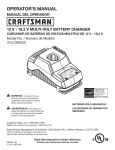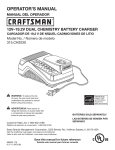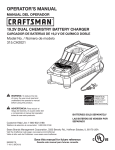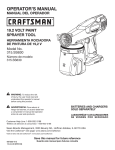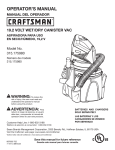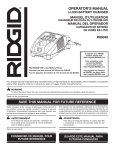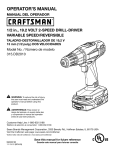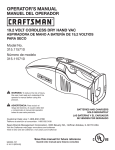Download Craftsman C3 Owner's Manual
Transcript
OPERATOR’S MANUAL MANUAL DEL OPERADOR 19.2 V MAINTENANCE STATION 4-PORT CHARGER CARGADOR DE 19,2 V CARGADOR CUATRO MAINTENANCE STATION Model No. / Numero de Modelo 315.CH2000 WARNING: To reduce the risk of injury, the user must read and understand the operator’s manual before using this product. ADVERTENCIA: Para reducir el riesgo de lesiones, el usuario debe leer y comprender el manual del operador antes de usar este producto. BATTERIES SOLD SEPARATELY LAS BATERÍAS SE VENDEN POR SEPARADO Customer Help Line: 1-800-932-3188 Teléfono de atención al consumidor: 1-800-932-3188 Sears Brands Management, 3333 Beverly Rd., Hoffman Estates, IL 60179 USA Visit the Craftsman web page: www.sears.com/craftsman Visite el sitio web de Craftsman: www.sears.com/craftsman 987000-855 1-17-12 (REV:03) Save this manual for future reference Guarde este manual para futuras consulta TABLE OF CONTENTS / ÍNDICE DE CONTENIDO ENGLISH ESPAÑOL Warranty.......................................................................2 Garantía.......................................................................2 Introduction..................................................................2 Introducción.................................................................2 Safety Rules for Charger..............................................3 Reglas de seguridad para el empleo del cargador......3 Symbols.......................................................................4 Símbolos......................................................................4 Features.......................................................................5 Características.............................................................5 Assembly.....................................................................5 Armado........................................................................5 Operation................................................................. 6-7 Funcionamiento....................................................... 6-7 Maintenance................................................................7 Mantenimiento.............................................................7 Figure numbers (illustrations)................................... ii-iii Figura numeras (ilustraciones)................................. ii-iii Parts Ordering / Service.............................. Back Page Pedidos de piezas / Servicio.................. Pág. posterior WARRANTY / GARANTÍA CRAFTSMAN® ONE YEAR LIMITED WARRANTY FOR ONE YEAR from the date of purchase, this product is warranted against any defects in material or workmanship. With proof of purchase, defective product will be replaced free of charge. For warranty coverage details to obtain free replacement, visit the web site: www.craftsman.com This warranty is void if this product is ever used while providing commercial services or if rented to another person. This warranty gives you specific legal rights, and you may also have other rights which vary from state to state. Sears Brands Management Corporation, Hoffman Estates, IL 60179 *** GARANTÍA LIMITADA DE CRAFTSMAN POR UN AÑO Este producto tiene garantía por cualquier defecto en material o mano de obra DURANTE UN AÑO desde la fecha de compra. Los productos defectuosos se remplazarán sin cargo si presenta un comprobante de pago. Si desea conocer los detalles de la cobertura de la garantía para conseguir reparaciones o recambios, visite el sitio Web: www.craftsman.com La garantía pierde validez si este producto se utiliza mientras se prestan servicios comerciales o si se alquila a otra persona. Esta garantía le otorga derechos legales específicos y también puede gozar de otros derechos que varían según el estado. Sears Brands Management Corporation, Hoffman Estates, IL 60179 INTRODUCTION / INTRODUCCIÓN This tool has many features for making its use more pleasant and enjoyable. Safety, performance, and d ependability have been given top priority in the design of this product making it easy to maintain and operate. *** Esta herramienta ofrece numerosas características para hacer más agradable y placentero su uso. En el diseño de este producto se ha conferido prioridad a la seguridad, el desempeño y la fiabilidad, por lo cual se facilita su manejo y mantenimiento. 2 SAFETY RULES FOR CHARGER WARNING! READ AND UNDERSTAND ALL INSTRUCTIONS. Failure to follow all instructions listed below, may result in electric shock, fire and/or serious personal injury. Before using charger, read all instructions and cautionary markings in this manual, on charger, battery, and product using battery to prevent misuse of the products and possible injury or damage. WARNING: Charge only one Craftsman® nickelcadmium or lithium-ion rechargeable battery at a time. Other types of batteries may burst, causing personal injury or damage. For compatible battery packs see tool/appliance/battery pack/charger correlation supplement 988000-272. Do not use charger outdoors or expose to wet or damp conditions. Water entering charger will increase the risk of electric shock. Use of an attachment not recommended or sold by the battery charger manufacturer may result in a risk of fire, electric shock, or injury to persons. Following this rule will reduce the risk of electric shock, fire, or serious personal injury. Do not abuse cord or charger. Never use the cord to carry the charger. Do not pull the charger cord rather than the plug when disconnecting from receptacle. Damage to the cord or charger could occur and create an electric shock hazard. Replace damaged cords immediately. Make sure cord is located so that it will not be stepped on, tripped over, come in contact with sharp edges or moving parts or otherwise subjected to damage or stress. This will reduce the risk of accidental falls, which could cause injury, and damage to the cord, which could result in electric shock. Keep cord and charger from heat to prevent damage to housing or internal parts. Do not let gasoline, oils, petroleum-based products, etc. come in contact with plastic parts. They contain chemicals that can damage, weaken, or destroy plastic. Always wear eye protection with side shields marked to comply with ANSI Z87.1. Failure to do so could result in objects being thrown into your eyes resulting in possible serious injury. An extension cord should not be used unless absolutely necessary. Use of improper extension cord could result in a risk of fire and electric shock. If extension cord must be used, make sure: a. That pins on plug of extension cord are the same number, size and shape as those of plug on charger. b. That extension cord is properly wired and in good electrical condition; and c. That wire size is large enough for AC ampere rating of charger as specified below: Cord Length (Feet) 25' 50' 100' Cord Size (AWG) 16 16 16 NOTE: AWG = American Wire Gauge Do not operate charger with a damaged cord or plug, which could cause shorting and electric shock. If damaged, have the charger replaced by an authorized serviceman. Do not operate charger if it has received a sharp blow, been dropped, or otherwise damaged in any way. Take it to an authorized serviceman for electrical check to determine if the charger is in good working order. Do not disassemble charger. Take it to an authorized serviceman when service or repair is required. Incorrect reassembly may result in a risk of electric shock or fire. Unplug charger from outlet before attempting any maintenance or cleaning to reduce the risk of electric shock. Disconnect charger from the power supply when not in use. This will reduce the risk of electric shock or damage to the charger if metal items should fall into the opening. It also will help prevent damage to the charger during a power surge. Risk of electric shock. Do not touch uninsulated portion of output connector or uninsulated battery terminal. Save these instructions. Refer to them frequently and use them to instruct others who may use this tool. If you loan someone this tool, loan them these instructions also to prevent misuse of the product and possible injury. IMPORTANT SAFETY INSTRUCTIONS 1. SAVE THESE INSTRUCTIONS - DANGER: TO REDUCE RISK OF FIRE OR ELECTRIC SHOCK CAREFULLY FOLLOW THESE INSTRUCTIONS. This manual contains important safety and operating instructions for battery charger 315.CH2000. 2. Before using battery charger, read all instructions and cautionary markings on battery charger, battery, and product using battery. CAUTION: 3. To reduce the risk of injury, charge only lithium-ion or nickel-cadmium rechargeable batteries. Other types of batteries may burst, causing personal injury or damage. 3 - English SYMBOLS The following signal words and meanings are intended to explain the levels of risk associated with this product. SYMBOL SIGNAL MEANING DANGER: Indicates an imminently hazardous situation, which, if not avoided, will result in death or serious injury. WARNING: Indicates a potentially hazardous situation, which, if not avoided, could result in death or serious injury. CAUTION: Indicates a potentially hazardous situation, which, if not avoided, may result in minor or moderate injury. CAUTION: (Without Safety Alert Symbol) Indicates a situation that may result in property damage. Some of the following symbols may be used on this product. Please study them and learn their meaning. Proper interpretation of these symbols will allow you to operate the product better and safer. SYMBOL NAME DESIGNATION/EXPLANATION Safety Alert Indicates a potential personal injury hazard. Read Operator’s Manual To reduce the risk of injury, user must read and understand operator’s manual before using this product. Eye Protection Always wear eye protection with side shields marked to comply with ANSI Z87.1. Wet Conditions Alert Do not expose to rain or use in damp locations. V Volts Voltage Hz Hertz Frequency (cycles per second) W Watt Power Alternating Current Type of current Direct Current Type or a characteristic of current CALIFORNIA PROPOSITION 65 WARNING: This product may contain chemicals, including lead, known to the State of California to cause cancer, birth defects or other reproductive harm. Wash hands immediately after handling. 4 - English FEATURES PRODUCT SPECIFICATIONS Battery Pack Voltage................................................................................................................................................ 19.2 V DC Charger Input......................................................................................................................................... 120 V, AC only, 60 Hz Charge Time............................................................................................1 hour per port (Li-ion) / 45 minutes per port (NiCd) KNOW YOUR CHARGER DIAGNOSTIC FEEDBACK See Figure 1, page i. The safe use of this product requires an understanding of the information on the product and in this operator’s manual. Before use of this product, familiarize yourself with all operating features and safety rules. LEDs provide feedback to indicate whether the battery pack is charging, fully charged, or defective. BATTERY PROTECTION FEATURES KEY HOLE HANGER DUAL CHEMISTRY The battery charger can charge either lithium-ion or nickel-cadmium batteries. Craftsman 19.2 V lithium-ion batteries are designed with features that protect the lithium-ion cells and maximize battery life. C3 STATUS INDICATOR BUTTON The charger has a key hole hanging feature for convenient, space saving storage. Screws should be installed so that the center distance is 8-1/2 in. WALL MOUNT BRACKET The C3 status indicator button wakes the charger from sleep mode and indicates charger status. The charger comes with a space-saving wall mount bracket for quick and easy storage. Screws should be installed so that the center distance is 10-1/4 in. CORD TRACK Inserting the cord into the cord track keeps the power cord flat against the charger for hanging on the wall mount or sitting on a flat surface. ASSEMBLY UNPACKING WARNING: If any parts are damaged or missing This product has been shipped completely assembled. n Carefully remove the product and any accessories from the box. Make sure that all items listed in the packing list are included. WARNING: Do not attempt to modify this product WARNING: Do not use this product if it is not completely assembled or if any parts appear to be missing or damaged. Use of a product that is not properly and completely assembled could result in serious personal injury. n Inspect the product carefully to make sure no breakage or damage occurred during shipping. n Do not discard the packing material until you have carefully inspected and satisfactorily operated the product. n If any parts are damaged or missing, please call 1-800-932-3188 for assistance. PACKING LIST Charger Wall Mount Bracket Operator’s Manual do not operate this product until the parts are replaced. Use of this product with damaged or missing parts could result in serious personal injury. or create accessories not recommended for use with this product. Any such alteration or modification is misuse and could result in a hazardous condition leading to possible serious personal injury. ASSEMBLING WALL MOUNT BRACKET See Figures 2 - 3, page i n Find desired location indoors and away from any objects that could block vents on charger. Locate a wall stud to securely mount bracket. n You will need two #8 - 2 1/2 in. screws (not included) n Use a level to be sure that bracket is in a vertical position. Use a pencil to mark screw hole placement. Screws should be installed so that the center distance is 10-1/4 in. n Install screws to securely attach bracket. n Place bottom end of charger into bracket then snap top of charger securely into bracket. n Charger should fit snugly and securely in bracket. 5 - English OPERATION WARNING: Do not allow familiarity with products to make you careless. Remember that a careless fraction of a second is sufficient to inflict serious injury. WARNING: Always wear eye protection with side shields marked to comply with ANSI Z87.1. Failure to do so could result in objects being thrown into your eyes resulting in possible serious injury. WARNING: Do not use any attachments or accessories not recommended by the manufacturer of this product. The use of attachments or accessories not recommended can result in serious personal injury. APPLICATIONS You may use this product for the following purpose: Charging compatible 19.2 Volt Craftsman battery packs NOTE: Battery packs will charge one at a time, in the order they are inserted into the battery ports. Charger does NOT charge multiple batteries at one time. CAUTION: If at any point during the charging process none of the LEDs are lit, remove the battery pack from the charger to avoid damaging the product. DO NOT insert another battery. Return the charger and battery to your nearest service center for service or replacement. CAUTION: Charge in a well ventilated area. Do not block charger vents. Keep them clear to allow proper ventilation. LITHIUM-ION BATTERY PROTECTION FEATURES 19.2 V lithium-ion battery packs are designed with features that protect the lithium-ion cells and maximize battery life. If the tool stops during use, release the trigger to reset and resume operation. If the tool still does not work, the battery needs to be recharged. NOTE: The LED charge indicator light will not work if the battery protection feature has caused the battery pack to stop powering the tool. When the battery pack resets itself, the LED will again function. LED FUNCTIONS OF CHARGER See Figures 4 and 5, pages ii - iii. BATTERY PORT LED WILL BE ON TO INDICATE STATUS OF BATTERY PACK: Red LED on, Green LED off = Ready to charge battery pack. Red LED flashing, Green LED off = Battery is being tested. Red LED /Green LED flashing at the same time = Battery is defective. Red LED on, Green LED flashing = Battery is charging. Red LED off, Green LED on = Battery is fully charged. Red LED/Green LED flashing alternately = Port error. The battery pack is not properly inserted in the battery port. NOTE: If the battery pack is correctly inserted, and the Port Error LEDs are still flashing, do not insert the battery pack into a different port. It may be defective. C3 STATUS INDICATOR BUTTON FUNCTIONS C3 button is off = Power is off. C3 button shows continuous blue light = Power is on. C3 button continuously blinking on/off = Charger is in maintenance mode, keeping the battery pack in charged status. C3 button continuously fades on/off = Charger is in energy save (sleep) mode. Pressing the C3 button will power the charger on again. C3 button alternately fades on/off, then blinks on/off = Status alert. Push the C3 button to check the status of battery packs in charger ports. The LEDs for the pack with the error will begin to flash when the C3 button is pressed. CHARGING A BATTERY PACK See Figure 6, page ii. Battery packs are shipped in a low charge condition to prevent possible problems. Therefore, you should charge them before first use. If the charger does not charge the battery pack under normal circumstances, return both the battery pack and charger to your nearest repair center for electrical check. Make sure the power supply is normal household voltage, 120 volts, AC only, 60 Hz. Connect the charger to a power supply. Attach the battery pack to the charger by aligning the raised ribs on the battery pack with the grooves in the charger, then slide the battery pack onto the charger. Press down on the battery pack to be sure contacts on the battery pack engage properly with contacts in the charger. Latches should snap into place to ensure battery is correctly connected. Do not place the charger in an area of extreme heat or cold. It will work best at normal room temperature. NOTE: The charger and battery pack should be placed in a location where the temperature is more than 50°F but less than 96°F. The battery pack may become slightly warm to the touch while charging. This is normal and does not indicate a problem. 6 - English OPERATION After charging is complete, the C3 button will blink continuously while the charger is in Maintenance mode. After completing maintenance mode, the C3 button will begin fading on/off continuously. This indicates the battery is fully charged and the charger is in Energy Save Mode. Charger will periodically wake from Energy Save mode to ensure the battery pack remains in a fully charged state. To remove the battery pack from the charger, depress the latches on the sides of the battery pack and separate battery from charger. CHARGING A HOT BATTERY PACK When using a tool continuously, the battery pack may become hot. A hot battery pack may be placed directly onto the charger port but charging will not begin until the battery temperature cools to within acceptable temperature range. When a hot battery pack is placed on the charger, the red LED will begin flashing and the green LED will be off. When the battery pack cools to approximately 120°F (40°C), the charger will automatically begin charging. CHARGING A COLD BATTERY PACK A cold battery pack may be placed directly onto the charger port but charging will not begin until the battery temperature warms to within acceptable temperature range. When a cold battery pack is placed on the charger, the red LED will begin flashing and the green LED will be off. When the battery pack warms to approximately 32°F (0°C), the charger will automatically begin charging. FCC COMPLIANCE This device complies with Part 15 of the FCC Rules. Operation is subject to the following two conditions: 1. This device may not cause harmful interference, and 2. This device must accept any interference received, including interference that may cause undesired operation. This equipment has been tested and found to comply with the limits for a Class B digital device, pursuant to Part 15 of the FCC rules. These limits are designed to provide reasonable protection against harmful interference in a residential installation. This equipment generates, uses, and can radiate radio frequency energy and, if not installed and used in accordance with the instructions, may cause harmful interference to radio communications. However, there is no guarantee that the interference will not occur in a particular installation. If this equipment does cause harmful interference to radio or television reception, which can be determined by turning the equipment off and on, the user is encouraged to try to correct the interference by one or more of the following measures: Reorient or relocate the receiving antenna. Increase the separation between the equipment and receiver. Connect the equipment into an outlet on a circuit different from that of the receiver. Consult the dealer or an experienced radio/TV technician for help. MAINTENANCE WARNING: When servicing, use only identical WARNING: Do not at any time let brake fluids, replacement parts. Use of any other parts could create a hazard or cause product damage. gasoline, petroleum-based products, penetrating oils, etc., come in contact with plastic parts. Chemicals can damage, weaken or destroy plastic which may result in serious personal injury. WARNING: To avoid serious personal injury, always remove the battery pack from the tool when cleaning or performing any maintenance. GENERAL MAINTENANCE Avoid using solvents when cleaning plastic parts. Most plastics are susceptible to damage from various types of commercial solvents and may be damaged by their use. Use clean cloths to remove dirt, dust, oil, grease, etc. STORAGE Always remove the battery pack before storing the charger or any time the charger is unplugged. 7 - English Fig. 1 B D F A H I 8 1/2 in. (215,9 mm) C E G H A-Charger (cargador) B-Battery port (receptáculo para baterías) C-Blue C3 LED status button (botón azul indicador de estado C3 D - Battery port LEDs (diodos luminiscentes del receptáculo para baterías) E-Bumper (parachoques) F-Carry handle (mango de acarreo) G-Wall mount bracket (sorporte de montaje en pared) H-“Key hole” hanger (colgador tipo “bocallave”) I -Cord track (riel para el cordon) Fig. 2 Fig. 3 C A B D 10-1/4 in. (260 mm) A D A-Wall mount bracket (sorporte de montaje en pared) B-Pencil (lapiz) C-Screwdriver (destornillador) D-Screws (not included) ( tornillos [no incluida]) A-Wall mount bracket (clip del cinturón) i Fig. 4 B A A-Red LED (diodo rojo) B-Green LED (diodo verde) C-Battery port (receptáculo para baterías) C Fig. 5 LED FUNCTIONS LED INDICATOR RED LED GREEN LED ACTION ON OFF Ready to charge battery pack FLASHING OFF Battery is being tested FLASHING FLASHING Battery is defective ON FLASHING Battery is charging OFF ON Battery is fully charged Flashing alternately with GREEN LED Flashing alternately with RED LED Port error. The battery pack is not properly inserted in the battery port. C3 STATUS INDICATOR BUTTON FUNCTIONS C3 button is off Power is off C3 button shows continuous blue light Power is on C3 button continuously blinking on/off Charger is in maintenance mode, keeping the battery pack in charged status. C3 button continuously fades on/off Charger is in energy save (sleep) mode. Pressing the C3 button will power the charger on again. C3 button alternately fades on/off, then blinks on/off Status alert. Push the C3 button to check the status of battery packs in charger ports. The LEDs for the pack with the error will begin to flash when the C3 button is pressed. ii Fig. 5 FUNCIONAMIENTO DE LOS DIODOS LUMINISCENTES INDICADOR DEL DIODO ROJO DIODO VERDE ACCIÓN ENCENDIDO APAGADO Listo para cargar el paquete de baterías DESTELLANDO APAGADO Se está probando la batería DESTELLANDO DESTELLANDO La batería está defectuosa ENCENDIDO DESTELLANDO La batería se está cargado APAGADO ENCENDIDO La batería está completo cargado Diodo rojo o diodo verde destellando alternadamente Error de puerto. El paquete de baterías no está correctamente insertado en el receptáculo para baterías. FUNCIONES DEL BOTÓN DE INDICADOR DE ESTADO C3 El botón C3 está apagado El suministro eléctrico está desconectado El botón C3 muestra una El suministro eléctrico está conectado luz azul continua El botón C3 parpadea en forma continua. El cargador está en el modo mantenimiento y mantiene cargado el paquete de baterías. El botón C3 aparece y desaparece en forma continua. El cargador está en el modo de ahorro de energía (suspensión). Al oprimir el botón C3, se encenderá nuevamente el cargador. El botón C3 aparece y desaparece alternadamente, luego parpadea. Alerta de estado. Oprima el botón C3 para verificar el estado de los paquetes de baterías en los puertos del cargador. Los diodos luminiscentes para el paquete con el error comenzarán a destellar. Fig. 6 LOS PESTILLOS HARÁN UN CLIC CUANDO EL PAQUETE DE BATERÍAS ENTRE EN SU LUGAR iii REGLAS DE SEGURIDAD PARA EL EMPLEO DEL CARGADOR ¡ADVERTENCIA! Lea y comprenda todas las instrucciones. El incumplimiento de las instrucciones señaladas abajo puede causar descargas eléctricas, incendios y lesiones corporales serias. Antes de emplear el cargador de baterías, lea todas las instrucciones y las marcas precautorias del manual, del cargador, de la batería y del producto con el cual se utiliza dicha batería, con el fin de evitar un empleo indebido del producto y posibles lesiones corporales o daños físicos. ADVERTENCIA: Cargue sólo una batería recargable de níquel-cadmio a la vez. Los otros tipos de baterías pueden explotar y ocasionar daños y lesiones corporales. Para obtener paquetes de baterías compatibles, consulte el complemento de correlación de herramienta/artefacto/ paquete de batería/cargador 988000-272. No utilice el cargador a la intemperie ni lo exponga a condiciones húmedas o mojadas. La introducción de agua en el cargador aumenta el riesgo de una descarga eléctrica. El uso de un accesorio no recomendado o vendido por el fabricante del cargador de baterías puede significar un riesgo de incendio, descarga eléctrica o lesiones corporales. Con el cumplimiento de esta regla se reduce el riesgo de una descarga eléctrica, incendio o lesión seria. No maltrate el cordón eléctrico ni el cargador. Para trasladar el cargador nunca lo sostenga del cordón. No tire del cordón del cargador en lugar de tirar de la clavija al desconectar el aparato de la toma de corriente. Puede dañar el cordón o el cargador y causar un peligro de descarga eléctrica. Cambie de inmediato todo cordón eléctrico dañado. Asegúrese de que el cordón eléctrico esté ubicado de tal manera que nadie lo pise o se tropiece con él, no toque bordes afilados o piezas en movimiento ni quede sujeto a daños ni tensiones. De esta manera se reduce el riesgo de caídas accidentales que pudieran causar lesiones personales y daños al cordón, lo cual podría ocasionar una descarga eléctrica. Mantenga el cordón y el cargador alejados del calor para evitar dañar el alojamiento o las partes internas de la unidad. No permita que gasolina, aceites, productos a base de petróleo, etc., lleguen a tocar las piezas de plástico. Dichos productos contienen compuestos químicos que pueden dañar, debilitar o destruir el plástico. Siempre póngase protección ocular con la marca de cumplimiento de la norma ANSI Z87.1. Si no cumple esta advertencia, los objetos que salen despedidos pueden producirle lesiones serias en los ojos. No debe emplearse un cordón de extensión a menos que sea absolutamente necesario. El empleo de un cordón de extensión inadecuado puede significar un riesgo de incendio o descarga eléctrica. Si es necesario utilizar un cordón de extensión, asegúrese: a. De que las patillas de la clavija del cordón de extensión vengan en el mismo número, tamaño y forma que las de la clavija del cargador. b. Que el cordón de extensión esté alambrado correctamente y en buenas condiciones eléctricas, y c. Que el tamaño del alambre sea del tamaño suficiente para el amperaje de CA nominal del cargador como se especifica a continuación: Long. cordón (pies) 25' 50' 100' Calibre cordón (AWG) 16 16 16 NOTA: AWG = Calibre conductores norma americana No utilice el cargador si está dañado el cordón o la clavija, ya que podría causar un corto circuito y una descarga eléctrica. Si está dañada una pieza, un técnico de servicio autorizado debe reemplazar el cargador. No utilice el cargador si el mismo ha sufrido una caída, un golpe sólido o un daño de cualquier tipo. Llévelo a un técnico de servicio autorizado para una revisión eléctrica y así determinar si el cargador está en buenas condiciones de funcionamiento. No desarme el cargador. Llévelo a un técnico de servicio autorizado si requiere servicio o una reparación. Si se rearma la unidad de manera incorrecta, puede presentarse un riesgo de descarga eléctrica o incendio. Para reducir el riesgo de una descarga eléctrica, desconecte el cargador de la toma de corriente antes de iniciar una tarea de mantenimiento o de limpieza. Cuando no esté en uso el cargador desconéctelo del suministro de voltaje. De esta manera se reduce el riesgo de una descarga eléctrica o daños al cargador si artículos metálicos caen en la abertura. Esto también ayuda a evitar dañar el cargador en el caso de una subida de voltaje. Riesgo de descarga eléctrica. No toque ninguna parte sin aislar del conector de salida, ni ninguna terminal de las baterías en tales condiciones. Guarde estas instrucciones. Consúltelas con frecuencia y empléelas para instruir a otras personas que puedan utilizar esta herramienta. Si presta a alguien esta herramienta, facilítele también las instrucciones con el fin de evitar un uso indebido del producto y posibles lesiones. INSTRUCCIONES DE SEGURIDAD IMPORTANTES GUARDE ESTAS INSTRUCCIONES - PELIGRO: PARA REDUCIR EL RIESGO DE INCENDIOS 1. O DESCARGA ELÉCTRICA, SIGA CUIDADOSAMENTE ESTAS INSTRUCCIONES. Este manual contiene instrucciones importantes respecto a la seguridad y funcionamiento de los cargador de baterías 315.CH2000. 3. 2. Antes de emplear el cargador de baterías lea todas las instrucciones y las indicaciones precautorias del cargador de baterías, de las baterías y del producto con el que se utilizan las baterías. PRECAUCIÓN: Para reducir el riesgo de lesiones, sólo cargue baterías recargables de iones de litio y níquel-cadmio. Otros tipos de baterías pueden estallar y causar lesiones corporales así como daños materiales. 3 - Español SÍMBOLOS Las siguientes palabras de señalización y sus significados tienen el objeto de explicar los niveles de riesgo relacionados con este producto. SÍMBOLOSEÑAL SIGNIFICADO PELIGRO: Indica una situación peligrosa inminente, la cual, si no se evita, causará la muerte o lesiones serias. ADVERTENCIA: Indica una situación peligrosa posible, la cual, si no se evita, podría causar la muerte o lesiones serias. PRECAUCIÓN: Indica una situación peligrosa posible, la cual, si no se evita, podría causar lesiones menores o leves. (sin el símbolo de alerta de seguridad) Indica una situación que puede producir daños materiales. PRECAUCIÓN: Es posible que se empleen en este producto algunos de los siguientes símbolos. Le suplicamos estudiarlos y aprender su significado. Una correcta interpretación de estos símbolos le permitirá utilizar mejor y de manera más segura el producto. SÍMBOLO NOMBRE DENOMINACIÓN/EXPLICACIÓN Alerta de seguridad Indica un peligro posible de lesiones personales. Lea manual del operador Para reducir el riesgo de lesiones, el usuario debe leer y comprender el manual del operador antes de usar este producto. Protección ocular Siempre póngase protección ocular con protección lateral con la marca de cumplimiento de la norma ANSI Z87.1. Alerta de condiciones húmedas No exponga la unidad a la lluvia ni la use en lugares húmedos. V Volts Voltaje Hz Hertz Frecuencia (ciclos por segundo) W Watts Potencia Corriente alterna Tipo de corriente Corriente continua Tipo o característica de corriente CALIFORNIA - PROPUESTA DE LEY NÚM. 65 ADVERTENCIA: Este producto puede contener sustancias químicas (por ejemplo, plomo) reconocidas por el estado de California como causantes de cáncer, defectos congénitos y otras afecciones del aparato reproductor Lávese las manos después de utilazar el aparato. 4 - Español CARACTERÍSTICAS ESPECIFICACIONES DEL PRODUCTO Voltaje del paquetes de pilas....................................................................................................................................................... 19,2 V c.c. Corriente de entrada del cargador......................................................................................................................120 V, sólo corr. alt., 60 Hz Tiempo de carga....................................................................... 1 hora por puerto (iones de litio) / 45 minutos por puerto (níquel-cadmio) FAMILIARÍCESE CON EL CHARGER INFORMACIÓN DE DIAGNÓSTICO Vea la figura 1, página i. Los diodos luminiscentes indican si el paquetes de pilas se está cargando, está completamente cargado o está defectuoso. Para usar este producto con la debida seguridad se debe comprender la información indicada en la herramienta misma y en este manual. Antes de usar este producto, familiarícese con todas las características de funcionamiento y normas de seguridad del mismo. QUÍMICA DUAL El cargador cargar paquetes de baterías compatibles de níquelcadmio o iones de litio. COLGADOR TIPO BOCALLAVE CARACTERÍSTICAS DE PROTECCIÓN DE LAS BATERÍAS Las baterías de iones de litio Craftsman de 19,2 V están diseñadas con características que protegen las celdas de iones de litio y maximizan la duración de las baterías. BOTÓN INDICADOR DE ESTADO C3 El botón indicador de estado C3 enciende el cargador cuando éste está en modo suspensión e indica el estado del cargador. RIEL PARA EL CORDÓN El cargador dispone de una ranura en forma de bocallave para colgarlo que permite guardarlo de manera conveniente y economizadora de espacio. Los tornillos deben instalarse a una distancia central entre sí de 216 mm (8-1/2 pulg.). SUPPORT DE MONTAGE MURAL El cargador viene con un soporte de montaje en pared economizador de espacio para poder almacenarlo de forma rápida y sencilla. Los tornillos deben instalarse a una distancia central entre sí de 260 mm (10-1/4 pulg.). Al insertar el cordón en el riel, el cordón de corriente permanecerá plano contra el cargador para colgarlo en el montaje de pared o asentarlo sobre una superficie plana. ARMADO DESEMPAQUETADO ADVERTENCIA: Si des pièces manquent ou sont Este producto se empaca completamente armado. endommagées, ne pas utiliser ce produit avant qu’elles aient été remplacées. Le fait d’utiliser ce produit même s’il contient des pièces endommagées ou s’il lui manque des pièces peut entraîner des blessures graves. n Extraiga cuidadosamente de la caja el producto y los accesorios. Compruebe que estén presentes todos los artículos enumerados en la lista de empaquetado. ADVERTENCIA: No use este producto si no está totalmente ensamblado o si alguna pieza falta o está dañada. Si utiliza un producto que no se encuentra ensamblado de forma correcta y completa, puede sufrir lesiones graves. n Inspeccione cuidadosamente el producto, para verificar que no haya sufrido ninguna rotura o daño durante el transporte. ADVERTENCIA: Ne pas brancher sur le secteur avant d’avoir terminé l’assemblage. Le non respect de cet avertissement peut causer un démarrage accidentel, entraînant des blessures graves. ARMADO DEL SOPORTE DE MONTAJE EN PARED Vea las figuras 2 y 3, página i. n No deseche el material de empaquetado hasta que haya inspeccionado el producto con cuidado y la haya utilizado satisfactoriamente. n Busque la ubicación deseada en el interior y lejos de cualquier objeto que pueda bloquear las rejillas de ventilación del cargador. Ubique un perno de pared para montar firmemente el soporte. n Si hay piezas dañadas o faltantes, le suplicamos llamar al 1-800-932-3188, donde le brindaremos asistencia. n Necesitará dos tornillos #8 de 63,5 mm (2-1/2 pulg.) (no vienen incluidos). LISTA DE EMPAQUETADO Soporte de montaje en pared n Utilice un nivel para asegurarse de que el soporte se encuentre en posición vertical. Con un lápiz, marque la ubicación del orificio del tornillo. Los tornillos deben instalarse a una distancia central entre sí de 260 mm (10-1/4 pulg.). Manual del operador n Instale los tornillos para colocar firmemente el soporte. Cargador n Introduzca el extremo inferior del cargador y luego el extremo superior de éste a presión en el soporte. n El cargador debe quedar bien ajustado y firme en el soporte. 5 - Español FUNCIONAMIENTO ADVERTENCIA: No permita que su familarización con los productos lo vuelva descuidado. Tenga presente que un descuido de un instante es suficiente para causar una lesión grave. ADVERTENCIA: Siempre póngase protección ocular con la marca de cumplimiento de la norma ANSI Z87.1. La inobservancia de esta advertencia puede permitir que los objetos lanzados hacia los ojos puedan provocarle lesiones graves. ADVERTENCIA: No utilice ningún aditamento o accesorio no recomendado por el fabricante de esta herramienta. El empleo de aditamentos o accesorios no recomendandos puede causar lesiones graves. APLICACIONES Este producto puede emplearse para los fines siguientes: Cargar paquetes de baterías compatibles de 19,2 V. NOTE: Los paquetes de baterías se cargarán de a uno por vez en el orden que se introduzcan en los receptáculos para baterías. El cargador NO carga varias baterías al mismo tiempo. PRECAUCIÓN: Si en cualquier momento durante el proceso de carga no está encendido ninguno de los diodos luminiscentes, retire del cargador el paquetes de pilas para evitar dañar el producto. NO introduzca otra batería. Devuelva el cargador y la batería al centro de servicio más cercano para su revisión o reemplazo. PRECAUCIÓN: Cargue en un área bien ventilada. No bloquee las rejillas de ventilación. Manténgalas libres para permitir una ventilación adecuada. Diodo rojo destellando, diodo verde apagado = se está probando la batería. Diodo rojo o diodo verde destellando al mismo tiempo = La batería está defectuosa. Diodo rojo encendido, diodo verde destellando = la batería se está cargado. Diodo rojo apagado, diodo verde encendido = la batería está completo cargado. Diodo rojo o diodo verde destellando alternadamente = Error de puerto. El paquetes de pilas no está correctamente insertado en el receptáculo para baterías. NOTE: Si el paquetes de pilas está insertado correctamente y los diodos luminiscentes del error de puerto continúan destellando, no inserte el paquetes de pilas en un puerto diferente. Puede estar defectuoso. FUNCIONES DEL BOTÓN DE INDICADOR DE ESTADO C3 El botón C3 está apagado = el suministro eléctrico está desconectado. El botón C3 muestra una luz azul continua = el suministro eléctrico está conectado. El botón C3 parpadea en forma continua = el cargador está en el modo mantenimiento y mantiene cargado el paquetes de pilas. El botón C3 aparece y desaparece en forma continua = el cargador está en el modo de ahorro de energía (suspensión). Al oprimir el botón C3, se encenderá nuevamente el cargador. El botón C3 aparece y desaparece alternadamente, luego parpadea = alerta de estado. Oprima el botón C3 para verificar el estado de los paquetes de baterías en los puertos del cargador. Los diodos luminiscentes para el paquete con el error comenzarán a destellar. CÓMO CARGAR EL PAQUETES DE PILAS CARACTERÍSTICAS DE PROTECCIÓN DE LAS BATERÍAS DE IONES DE LITIO Las baterías de iones de litio de 19,2 V están diseñadas con características que protegen las celdas de iones de litio y maximizan la duración de las baterías. Si la herramienta se detiene durante el uso, suelte el gatillo para reiniciarla y reanude el funcionamiento. Si aun así no funciona, se debe recargar la batería. NOTA: La luz indicadora de carga de diodo luminiscente no funciona si la característica de protección de las baterías ha provocado que el paquetes de pilas deje de suministrar corriente a la herramienta. Cuando el paquetes de pilas se reinicialice automáticamente, el diodo luminiscente volverá a funcionar. CARGADOR FUNCIONAMIENTO DE LOS DIODOS LUMINISCENTES DEL CARGADOR Vea las figuras 4 y 5, páginas ii y iii. LOS DIODOS LUMINISCENTES SE ENCIENDEN PARA INDICAR UN CIERTO ESTADO DEL CARGADOR Y DEL PAQUETES DE PILAS: Diodo rojo encendido, diodo verde apagado = la alimentación al cargador está encendida. Vea la figura 6, página ii. Los paquetes de pilas se embarcan con carga baja para evitar posibles problemas. Por lo tanto, debe cargarlas durante la noche antes de usarlas. Si el cargador no carga el paquete de pilas en circunstancias normales, regresea ambos, el paquete de pilas y el cargador, al centro de reparación más cercano, para que los revisen eléctricamente. Asegúrese de que el suministro de corriente sea sólo el doméstico normal, de 120 V, corr. alt, 60 Hz. Conecte el cargador al suministro de corriente. Conecte el paquete de pilas al cargador; para ello, alinee las costillas realzadas del primero con las ranuras del segundo, y después introduzca aquél en éste. Presione sobre el paquetes de pilas para asegurarse de que los contactos del paquetes de pilas se ubiquen de forma apropiada con respecto a los contactos del cargador. Los pasadores deben quedar fijos en su lugar para asegurar que el cargador se conecte correctamente. No coloque el cargador en ninguna área extremadamente calurosa o fría. Funciona mejor a la temperatura normal del interior. 6 - Español FUNCIONAMIENTO NOTA: El cargador y el paquete de pilas se deben colocar en un lugar donde la temperatura esté entre 10 y 39 °C (entre 50 y 100 °F). Es posible que el paquete de baterías se siente un poco caliente al tacto mientras está cargándose. Esto es normal y no indica ningún problema. Una vez que la carga esté completa, el botón C3 permanecerá encendido indicando el modo de Mantenimiento. Cuando el modo de mantenimiento esté completo, el botón C3 comenzará a encenderse y apagarse continuamente hasta desvanecerse. Esto indica que la batería está completamente cargada y el cargador está en el Modo de Ahorro de Energía. De vez en cuando, el cargador abandonará el Modo de Ahorro de Energía para garantizar que el paquete de baterías continúe completamente cargado. Para extraer el paquete de baterías del cargador, oprima los pestillos laterales del paquete de baterías y retirer la pile de le chargeur. CÓMO CARGAR LA BATERÍA CUANDO ESTÁ CALIENTE El paquete de baterías puede calentarse si se usa una herramienta de manera continua. Un paquete de baterías caliente puede colocarse directamente en el puerto del cargador, pero la carga solo se iniciará cuando la temperatura de la batería se enfríe hasta alcanzar un rango de temperatura aceptable. Cuando se coloque un paquete de baterías caliente en el cargador, la luz LED roja comenzará a titilar y la luz LED verde se apagará. Cuando el paquete de baterías se enfríe hasta llegar aproximadamente a los 120 ºF (40 ºC), se iniciará la carga de manera automática. CÓMO CARGAR LA BATERÍA CUANDO ESTÁ FRÍA Se puede colocar un paquete de baterías frío directamente en el puerto del cargador; sin embargo, la carga no comenzará hasta que la temperatura de las baterías aumente y se encuentre dentro del rango de temperatura aceptable. Se puede colocar un paquete de baterías frío directamente en el puerto del cargador; sin embargo, la carga no comenzará hasta que la temperatura de las baterías aumente y se encuentre dentro del rango de temperatura aceptable. Cuando el paquete de baterías se caliente hasta llegar aproximadamente a los 32 ºF (0 ºC), se iniciará la carga de manera automática. CUMPLIMIENTO DE LAS NORMAS DE LA FCC Este dispositivo cumple con la Parte 15 de las Normas de la FCC. El funcionamiento queda sujeto a las dos siguientes condiciones: 1. Este dispositivo no debe causar interferencias perjudiciales, y 2. Este dispositivo debe admitir toda interferencia recibida, incluso aquella que pudiera dificultar el funcionamiento esperado. Se ha verificado y determinado que este equipo cumple con los límites correspondientes a los dispositivos digitales de Clase B, de acuerdo con la Parte 15 de las Normas de la FCC. Estos límites están establecidos para proporcionar una protección razonable contra la interferencia dañina en las instalaciones residenciales. Este equipo genera, utiliza y puede irradiar energía de frecuencia de radio, y si no se instala y emplea de conformidad con las instrucciones, puede causar interferencia dañina a las radiocomunicaciones. No obstante, no hay garantía de que no ocurrirá ninguna interferencia en cada instalación en particular. Si este equipo causa interferencia dañina en la recepción de radio o televisión, lo cual puede determinarse apagando y luego encendiendo el equipo, se exhorta al usuario a tratar de corregir la interferencia tomando una o más de las siguientes medidas: Cambiar la orientación o ubicación de la antena receptora. Aumentar la separación entre el equipo y el aparato receptor. Conectar el equipo en una toma de corriente de un circuito diferente al que esté conectado el aparato receptor. Consultar al concesionario o a un técnico experimentado de radio y TV para que le brinden ayuda. MANTENIMIENTO ADVERTENCIA: Al dar servicio a la unidad, sólo utilice piezas de repuesto idénticas. El empleo de piezas diferentes puede causar un peligro o dañar el producto. Utilice paños limpios para eliminar la suciedad, polvo, aceite, grasa, etc. ADVERTENCIA: No permita en ningún momento que líquido para frenos, gasolina, productos a base de petróleo, aceites penetrantes, etc., entren en contacto con las piezas de plástico. Las sustancias químicas pueden dañar, debilitar o destruir el plástico, lo cual puede a su vez producir lesiones corporales graves. ADVERTENCIA: Para evitar lesiones corporales graves, siempre retire el paquetes de pilas de la herramienta al limpiarla o darle mantenimiento. MANTENIMIENTO GENERAL Evite el empleo de solventes al limpiar piezas de plástico. La mayor parte de los plásticos son susceptibles a diferentes tipos de solventes comerciales y pueden resultar dañados. ALMACENAMIENTO Siempre retire el paquete de baterías antes de almacenar el cargador o cada vez que el cargador esté desenchufado. 7 - Español
















